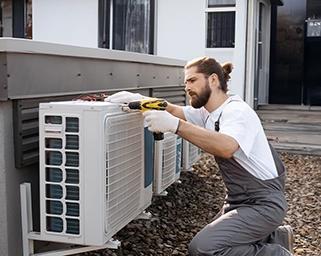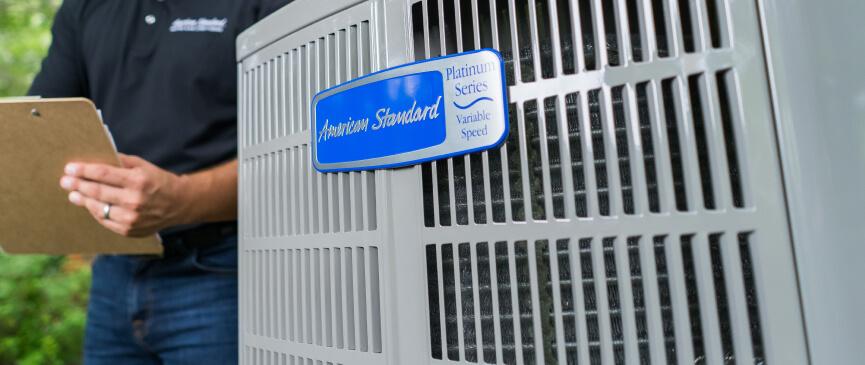How Much Does a New AC Unit Cost?
Summary: The cost of a new AC unit will depend on the efficiency, capacity, and number of cooling speeds. From basic to premium, costs can range from $8,000 to $20,000+ installed.

By Tom Moor
Most of us don’t give much thought to our air conditioners – until they stop working, of course. It’s only when the cool air disappears and the temperature ramps up that we realize just how much we rely on it to stay comfortable. If your AC struggled last season, ran inefficiently, or broke down entirely, chances are it will perform even worse this summer.
If you’re considering replacing your air conditioner, you probably have a lot of questions – including, how much does a new AC unit cost? To help you get started, connect with your local American Standard® dealer and take the first step toward lasting comfort and efficiency.
How much does a new AC cost?
The cost of a central air conditioner can vary quite a bit, depending on several key factors that we’ll explore shortly. Based on current estimates, a new system, including installation and local and state taxes, can range from about $8,800 for a basic, entry-level unit to upwards of $20,000 for a high-end system with all the bells and whistles. A mid-range model, meanwhile, may cost you somewhere between $10,800 and $16,400.
Remember, these price ranges are just estimates. An American Standard dealer can provide pricing based on your location, specific cooling needs, and budget.
Factors that impact the cost of a new AC system
There’s no one-size-fits-all solution when it comes to central air conditioning. Let’s take a closer look at the main factors that drive the price of a new AC system:
1. Unit size (tonnage)
AC units are sized based on their cooling capacity, which is measured in tons. One ton equals the ability to remove 12,000 BTUs of heat per hour. For example, a typical 2,000-square-foot home might require a 3-ton unit, though this can vary based on your home’s insulation, layout, and the climate zone you live in.
Sizing is a crucial step when buying a new air conditioner. A system that’s too small won’t cool your home effectively, while an oversized unit can lead to rising energy bills and high humidity. Unfortunately, the only fix for an improperly sized unit is AC replacement.
To get the right fit, your HVAC contractor should perform a Manual J Load Calculation to ensure the system runs efficiently and keeps your home comfortable. This detailed assessment considers factors like your home’s square footage, insulation levels, window size and placement, number of occupants, local climate, and even the direction your home faces.
2. SEER2 rating (efficiency)
Another key factor during the buying process is the efficiency of your new air conditioner, measured by the Seasonal Energy Efficiency Ratio (SEER2). A higher SEER2 rating means your unit uses less energy to cool your home, which can help lower monthly utility bills.
- 13.4 to 14.3 SEER2: This is the minimum SEER2 rating required by the U.S. Department of Energy, depending on where you live. Homes in northern states must meet a minimum of 13.4 SEER2, while those in the Southeast and Southwest regions are required to have units rated at 14.3 SEER2 or higher due to the increased cooling demands in warmer climates.
- 16-18 SEER2: These offer moderate efficiency and are common for standard systems.
- 20+ SEER2: These represent high-efficiency, premium systems designed to cut energy costs significantly.
While high-efficiency AC units require a larger investment upfront, their energy savings over time can help make up for the additional cost, especially if you plan to stay in your home for years to come.
At American Standard, we have 3 tiers of air conditioners: Silver, Gold, and Platinum. The SEER2 efficiency levels increase with each tier, and the price goes up as well, due to the superior technology and efficiency as you move up each tier. While the more efficient models will cost more up front, they will save you money on your cooling bills for years to come.
| Silver Series | SEER2 Up to 13.4 to up to 17 |
| Gold Series | SEER2 Up 16.2 to up to 17.1 |
| Platinum Series | SEER2 Up to 17 to up to 23.6 |
3. Compressor type
The type of compressor affects how your AC system handles temperature changes and overall efficiency:
- Single-Stage: Always runs at full capacity, providing consistent cooling but at higher energy costs. While they’re the most affordable option, they offer less precise temperature control.
- Two-Stage: Offers two distinct capacity levels (high and low), which allows the system to adjust to varying temperatures. This provides better comfort, more energy savings, and more accurate temperature control.
- Multi-Speed: Offers a limited number of preset speeds, allowing the system to adjust its cooling output based on demand. While not as flexible as variable-speed systems, multi-speed units still offer more efficiency and comfort than single-stage units.
- Variable-Speed: Continuously adjusts the speed of the compressor to match the cooling needs of your home. This results in precise temperature control, quieter operation, and the best energy efficiency. For example, the AccuComfort™ Variable Speed Platinum 20 Air Conditioner can gradually adjust its speed over a broader range to create a consistent flow of cool, comfortable air.
4. Existing ductwork
Often out of sight and out of mind, your ductwork’s condition can play a big role in the price for a new air conditioner installation. If your current ducts are damaged, leaky, or poorly designed, it can waste energy and reduce the system’s performance. Replacing air ducts can add anywhere from $3,000 to $10,000 to the overall cost of your new AC system.
It’s a good idea to have your ductwork checked before replacing your air conditioner. If your ducts are leaking or poorly designed, fixing or replacing them can improve airflow, help your new system run more efficiently, and even save you money over time.
5. Installation complexity
If your home has tricky attic access, several stories, or special electrical requirements, labor costs may rise. And if you live in a city or an area with strict building codes, that can also increase the price. That said, hiring a skilled installer is well worth it; they’ll make sure everything’s set up correctly, so your system runs efficiently and you’re not dealing with pesky problems later on.
6. Refrigerant type
The type of refrigerant your AC uses can also impact the overall cost of a new AC unit. While some R-410A units may still be available, this refrigerant is being phased out, meaning future recharges will become more expensive and more difficult to find. Newly manufactured systems starting in 2025 use more environmentally friendly refrigerants like R-454B, which may slightly increase upfront costs but offer better efficiency, long-term availability, and a smaller environmental footprint.
Optional features that can add value
You can enhance your new AC system with add-on features that improve comfort, indoor air quality (IAQ) and control. While these aren’t required, they can increase the performance of your system and add an extra layer of convenience.
- Smart Thermostat: Lets you control your home’s temperature remotely via an app and helps reduce energy use by learning and adapting to your schedule and preferences over time.
- Whole-Home Air Purifier: Enhances indoor air quality by removing allergens, dust, and pollutants which are ideal for households with allergy or asthma sufferers.
- Whole-Home Dehumidifier: Helps maintain balanced humidity levels, especially in damp or humid climates, improving comfort and preventing mold or mildew.
- Zoning System: Allows you to set different temperatures in separate areas of your home for better comfort and energy efficiency. A zoning system is especially helpful in multi-story homes or rooms with varying sun exposure.
These add-ons can increase the cost of your project by several hundred to a few thousand dollars, but they also provide long-term benefits in comfort, control, and system efficiency.
When should you replace your AC unit?
Replacing your air conditioner is a significant investment, so it’s worth knowing when it’s the right time to do it. One of the clearest indicators is age. Most AC units have a lifespan of 10-15 years. If your system is approaching or beyond that range, it’s likely becoming less efficient and more prone to breakdowns.
If you’ve noticed a recent spike in your energy bills without changing your cooling habits, that could also be a sign that your AC is working harder than it should be and costing you more. Frequent repairs are another red flag. It’s not uncommon to have one repair a season, but if you’re scheduling service calls every few months, those costs can add up quickly, and you may be better off putting your hard-earned money toward buying a new, more reliable system.
Uneven cooling throughout your home can signal an aging or improperly sized unit. Rooms that are too hot or too cold might mean your current system isn’t up to the task anymore.
Tax credits, utility rebates, and financing make new ACs more affordable
Federal tax credits, state rebates, local utility rebates, and manufacturers' rebates can help offset the cost of a new, high-efficiency system. Depending on where you live and what you install, you could save hundreds, even thousands, on your upgrade.
For example, you may qualify for a tax credit of 30% of the cost of buying and installing a split system central air conditioner with a SEER2 ≥ 17.0, according to ENERGY STAR. Tax credits are available on systems installed before December 31, 2025. You can stack these financial incentives. Visit our savings and offers page to see how much you could save.
If you’re like most homeowners, you don’t have the thousands of dollars on hand needed to buy a new AC. Fortunately, HVAC financing allows homeowners to spread out the cost of a new heating and cooling system through manageable monthly payments rather than paying everything up front.
This makes it easier to invest in a more energy-efficient or higher-performing unit without straining your budget. An American Standard dealer can walk you through various financing options.
Why choose American Standard for your next AC upgrade?
With over 100 years of experience, American Standard has earned a reputation for delivering high-quality, dependable cooling solutions designed to keep you comfortable year after year. Our systems are built to withstand extreme conditions and engineered with care, offering everything from reliable entry-level units to high-efficiency models with smart technology.
If you’re thinking about replacing your central air conditioner, contact your local American Standard dealer. They’ll carefully walk you through all of your options and find a system that fits your home and budget.
Author: Tom Moor
Expert review by Chelsea Hudson, Product Manager, Ducted Variable Speed Outdoor



